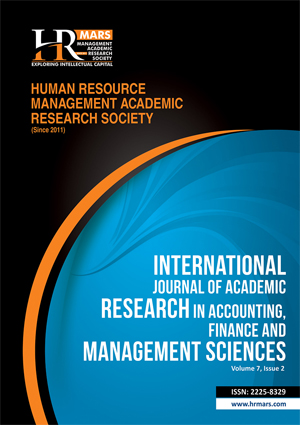
ISSN: 2225-8329
Open access
The majority of empirical literature on random walk behavior has interested on developed and emerging markets. However, few studies have been carried out to test the randomness of returns series on less developed markets. Damascus securities exchange is a young and nascent market in the Middle Eastern, started its operations in 2009; therefore, there is no empirical evidence testing the validity of random walk process. This paper examines whether daily stock returns on Damascus Securities Exchange follow a random walk for the period of 2009 to 2014. This study applies two parametric tests namely serial-correlation test and variance ratio test, and two non -parametric tests, i.e. runs test and BDS test. It is found that daily returns do not confirm to a random walk during the period under examination. This result is consistent in both parametric and non-parametric tests. The broad conclusion emerging from this study is that price returns might be predictable; hence, it is possible for investors to earn higher return than average by using historical successive prices.
Abraham, A., Seyyed, F. J., and Aisakran, S. A. (2002). Testing the Random Walk Behavior and Efficiency of the Gulf Stock Markets. Testing the Financial review, 37, 469-480.
Al-Ajmi, J., and Kim, J. H. (2012). Are Gulf stock markets efficient? Evidence from new multiple variance ratio tests. Applied Economics, 44 (4), 1737-1747.
Al-Jafari, M. (2011). Testing the weak form efficiency of Bahrain Securities Market. International Research Journal of Finance and Economics, 72, 14-24.
Al-Khazali O. M., Ding, D. K., and Pyun, C. S. (2007). A New Variance Ratio Test of Random Walk in Emerging Markets: A Revisit. The Financial Review, 42, 303-317.
Ayadi, O. F., and Pyun, C. S. (1994). An application of Variance Ratio Test to the Korean Securities Market. Journal of Banking and Finance, 18, 643-658.
Bachelier, L. (1900). Théorie de la speculation, Annales Scientifiques de L’École Normale Supérieure, Ph.D. Thesis, 17, 21-86..
Borges, M. (2008). Efficient Market Hypothesis in European Stock Market. Working Paper. WP 20/2008/DE/CIEF, 1-20.
Brock, W., Dechert, W., Sheinkman, J., and LeBaron, B. (1996). A Test for Independence based on the Correlation Dimension. Econometric Reviews, 15, 197-235.
Butler, K. C., and Malaikah, S. J. (1992). Efficiency and inefficiency in thinly traded stock markets: Kuwait and Saudi Arabia. Journal of Banking and Finance, 16, 197-210.
Chong, T. T. L., Lam, T. H., and Yan, I. K. M. (2012). Is the Chinese stock market really inefficient?. China Economic Review, 23, 122-137.
Collins, G. N., Opong, K. K., Danbolt, J., and Dewotor, F. S. (2011). Testing the weak-form efficiency in African stock market. Managerial Finance, 37 (3), 195-218.
Conrad, K.n and Jutter, D. (1973). Recent behaviour of stock market prices in Germany and the random walk hypothesis. Kyklos, 26.
De Pena, J., and Gil-Alana, L. A. (2002). Do Spanish Stock Market Prices follow a Random walk?. working paper, 02/02, Facultad de Ciencias Económicas y Empresariales, Universidad de Navarra
Ely, R. (2011). Returns predictability and stock market efficiency in Brazil. Revista Brasileira de Finanças, 9 (4), 571-584.
Evans, T. (2006). Efficiency tests of the UK financial futures markets and the impact of electronic trading systems. Applied Financial Economics, 16 (17), 1273-1283.
Fama, E. (1991). Efficient Capital markets II. Journal of Finance, 46, pp. 1575-1643.
Fama, E. F., and French, K. R. (1988). Permanent and Temporary Components of Stock Prices. Journal of Political Economy, 98, 247-273.
Fama, E. F. (1970). Efficient Capital Markets: A Review of Theory and Empirical Work. Journal of Finance, 25, pp. 383-417.
Fama, E. F. (1965). The behavior of stock market prices. Journal of business. Journal of business, 38 (1), 34-105.
Gitman, L. J., Joehnk, M. D., and Smart, S. B. (2011). Fundamentals of Investing (11 Ed.). Boston: person education.
Karemera, D., Ojah, K., and Cole, J. A. (1999). Random walks and market efficiency tests: Evidence from emerging equity markets. Review of Quantitative Finance and Accounting, 13 (2), 171-188.
Khababa, N. (1998). Behavior of stock prices in the Saudi Arabian Financial Market: Empirical research findings. Journal of Financial Management and Analysis, 11 (1), 48-55.
Lahmiri, S. (2013). Do MENA stock market returns follow a random walk process? International Journal of Industrial Engineering Computations, 4, 165-172.
Ljung, G. M., and Box, G. E. P. (1978). On a measure of lack of fit in time series models. Biometrika, 65 (2), 297-303.
Lo, A., and MacKinlay, A.C. (1988). Stock Market Prices do not follow Random Walks: Evidence from a Simple Specification Test. Review of Financial Studies, 1, 41-66.
Lo, A., and MacKinlay, A. C. (1989). The Size and Power of the Variance-Ratio Test in Finite Samples: A Monte Carlo Investigation. Journal of Econometrics, 40, 203-238.
Mukherji, S. (2011). Are stock returns still mean-reverting?. Review of Financial Economics, 20, 22-27.
Poon, S. (1996). Persistence and mean reversion in UK stock returns. European Financial Management, 2 (2), 169-196.
Poshakwale, S. (1996). Evidence on Weak Form Efficiency and Day of Weak Effect in the India Stock Market. Finance India, 3, pp. 605-616.
Urrutia, J. L. (1995). Tests of Random Walk and Market Efficiency for Latin American Emerging Equity Markets. Journal of Financial Research, 18, 299-309.
Worthington, A., and Higgs, H. (2004). Random Walks and Market Efficiency in European Equity Markets. Global Journal of Finance and Economics, 1, 59-78.
Worthington, A., and Higgs, H. (2003). Tests of Random Walks and Market Efficiency in Latin American Stock Markets. School of Economics and Finance Discussion Papers and Working Papers Series.
In-Text Citation: (Abbas, 2014)
To Cite this Article: Abbas, G. (2014). Testing Random Walk Behavior in the Damascus Securities Exchange. International Journal of Academic Research in Accounting Finance and Management Sciences, 4(4), 410–421.
Copyright: © 2014 The Author(s)
Published by Human Resource Management Academic Research Society (www.hrmars.com)
This article is published under the Creative Commons Attribution (CC BY 4.0) license. Anyone may reproduce, distribute, translate and create derivative works of this article (for both commercial and non-commercial purposes), subject to full attribution to the original publication and authors. The full terms of this license may be seen at: http://creativecommons.org/licences/by/4.0/legalcode